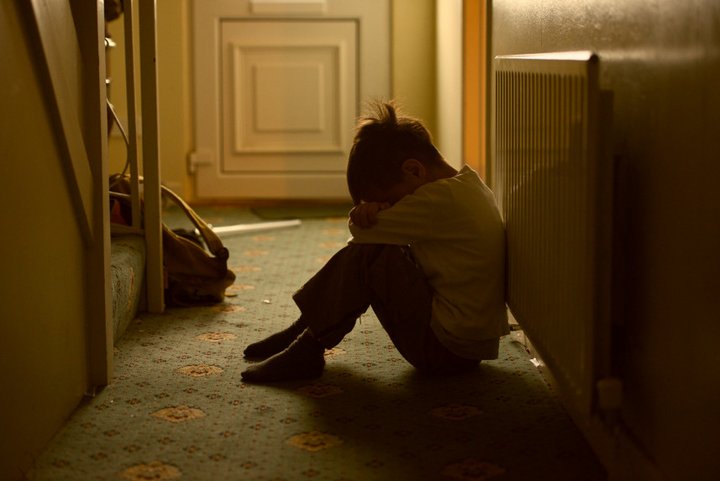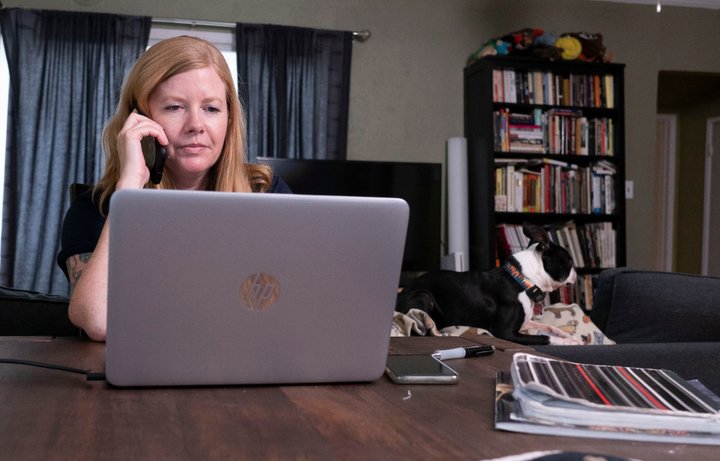
With schools closed and Californians ordered to stay at home, too many families may be in peril. Across the state calls to child abuse hotlines are down and reports of domestic violence are rising.
###
It’s become dangerous for some Californians to stay at home during the coronavirus pandemic.
Throughout California, families sheltering in place are cut off from school, work and friends — lifelines the most vulnerable rely upon. Domestic violence reports have surged and in places like Fresno County, grew 77 percent week over week in April. With fewer eyes on kids to report concerns about potential abuse, reports have plummeted; Los Angeles County saw half as many calls this month, and San Francisco and San Diego also reported a decline in calls to child welfare hotlines.
The peril some Californians face at home is no surprise to social workers, advocates, or even Gov. Gavin Newsom, who soon after he issued the stay-at-home order urged anyone in an abusive relationship to ask for help.
On Monday Newsom announced he earmarked an additional $42 million to support foster care services and on Tuesday eight legislators asked Newsom for emergency funds for domestic violence shelters. State and county social service agencies have scrambled to ensure staff can continue to monitor vulnerable children at home through online check-ins, and have developed protocols to continue investigating reports of abuse and neglect by visiting children in their homes.
“Unfortunately, home isn’t always a safe place – that’s why it’s crucial that we all have the tools necessary to protect ourselves and our loved ones. There’s never an excuse for violence against an intimate partner,” said Attorney General Xavier Becerra.
Newsom’s office released a video Monday of First Partner Jennifer Siebel Newsom asking community members in Spanish to keep an eye out for kids in trouble, to offer support to parents who might need it or to call a hotline to report concerns.
A pandemic-inspired approach to watching kids
Since officials closed schools and issued stay-at-home orders, county child welfare agencies have had to pivot quickly to investigate reports of abuse as well as to manage the thousands of children in their care at any given time.
State Social Services officials have eased rules to allow county case workers to conduct required foster care checks and to arrange child parent meetings virtually if possible.
“Everything we did before we are now doing virtually in terms of case conferences, supervision, even virtual visits between parents and children,” said Joan Miller, deputy director of Family and Child Services in San Francisco County’s Human Services Agency.
The infusion of $42 million will support some of those families. The bulk of the new money will go to families already being monitored by social services to help them stay together during the pandemic crisis. Remaining funds will support worker outreach to the most vulnerable families and foster families that need extra help to continue to care for kids. The money also will pay for technology for foster youth so they can stay in touch with family and their case worker, and participate in school.
“This funding is critical to strengthening communities and will help us prevent child abuse, support… families caring for children in foster care and provide much needed support to youth who are working toward self-sufficiency,” said Bobby Cagle, director of the Los Angeles County Department of Children and Family Services.
As they’ve adjusted to working virtually from home, agencies have taken care to maintain face-to-face contact for their two most critical activities — investigations into reports of neglect or abuse and placement of children removed from their homes, Miller said.
California determined such emergency response investigations are essential government functions to be continued during the stay-at-home order, along with its child welfare hotline.
“Investigations of the abuse or neglect of children must continue to occur,” the state Department of Social Services wrote in a letter to all local agencies. “It is essential that we perform this function during this time, particularly when stress may be heightened by health concerns, potential financial losses and increased caregiving responsibilities while children are not in school or participating in normal day-to-day activities.”
The state instructed county agencies to provide masks, gloves and other protective equipment to workers and train them to assess families for exposure to Covid-19 before they enter homes to investigate reports of abuse and neglect or to visit children.
Staying six feet away
Protective services worker Betty Short of San Francisco has added precautions to her routine when visiting families. Short’s caseload includes an at-risk family that did not have a cell phone with video capabilities until she supplied one this week, so she visited them in person.
“With social distancing I’m staying six feet away from them, wearing gloves, and maybe not going into the home but seeing them in the hallway or outside,” she said.
Short is managing nearly all of her 15 cases remotely. That means checking on them via video chat and setting up video meetings between the kids in foster care and their parents.
“I really feel for the families on my caseload, especially the ones that are not able to see their children in person,” she said. “It’s heartbreaking to talk with them and I think that’s why I’m having more contact with the parents. I’m trying to alleviate their anxiety and assuring them I’m checking in with the kids once a week.”
But seeing the kids via a video feed isn’t the same and Short worries about them too.
“It’s harder to talk about some things on video chat, in-person conversation flows more naturally,” she said. “With a lot of my kids we do activities while we are talking – puzzles, coloring, games – so they can focus on something else while talking to you, especially if it’s a difficult conversation. On a video screen those nuances are lost.”

Protective services worker Betty Short of San Francisco manages nearly all her 15 cases remotely. Photo courtesy of Betty Short.
To help monitor, counties are calling on friends and neighbors to be their eyes and ears on children. They are urging community members to step up in the absence of school personnel and health care providers.
“When there are not extra sets of eyes on children then I’m very concerned we are not getting the level of reporting that we would typically get,” Cagle said.
Kids who may be in abusive situations are home all the time and could be facing more pressure as adult abusers lose jobs, see their savings dwindle, close their businesses or lay off workers.
“They are operating under a tremendous amount of stress because of the crisis alone and in order for us to do our jobs we need to approach them with a great deal of understanding,” Cagle said. “While still making sure we get our jobs done.”
Los Angeles County Sheriff Alex Villanueva said suspected child abuse reports to his agency are down across the county. He also called on the community to take notice of family members, neighbors and friends who may be in danger and not wait to call authorities.
“Don’t hold on to the information and think it’s going to get better,” he said. “Under the current situation, with less eyes on the problem things don’t get better, they tend to devolve.”
In San Diego, officials hope online school meetings will provide an opportunity for school staff to check in with kids, albeit via video, spokeswoman Sarah Sweeney of the San Diego County Health & Human Services Agency told CalMatters in an email.
Domestic violence on the increase
Sometimes children are vulnerable because they are in a home where adults are the victims of domestic violence.
“We are concerned about the escalation that may be happening at home and the intensity of the violence that may be occurring,” said Ruth Glenn, CEO of the National Coalition Against Domestic Violence. “There’s a myriad of ways COVID can exacerbate a situation in which an abuser is abusing.”
Those who are experiencing domestic violence may not have access to their electronic devices or are afraid to call a friend. They may be working from home under the constant watch of their abuser, she said.
Glenn cautioned against any assumption that pandemic stressors create abusers, and excuse the violence. She said abusers typically already have been abusing and sheltering at home is an additional risk for victims.
“Survivors should feel that they can still reach out,” Glenn said. “The communities that are trying to help survivors are still there.”
Attorney General Becerra this week said courts are issuing emergency restraining orders that last up to 30 days and taking other legal steps to protect victims. Becerra’s office also released a list of resources for anyone facing intimate partner violence.
Tuesday, a bipartisan group of legislators sent Newsom a letter asking for $10 million in emergency funding to help domestic violence shelters.
“Domestic violence service center providers are adapting their services so they can provide safety and support in ways that are new, creative, and innovative,” they said in the letter, and that additional work requires funding.
Even without a pandemic, one in five women and one in seven men have suffered domestic violence, according to the U.S. Centers for Disease Control and Prevention. Now that people are staying at home, shelters are getting more calls for help, are spending more to help those already in shelters and are considering options like hotel rooms to shelter victims who need a place to go but who must be quarantined first.
At Sacramento County’s largest domestic violence services agency, WEAVE Inc., the number of calls from victims jumped significantly, said Julie Bornhoeft, chief strategy and sustainability officer for WEAVE.
WEAVE began preparing for the pandemic even before the order to shelter at home was issued.
Staff figured out how to work from home to offer virtual counseling sessions for victims and survivors, launched an online chat for victims who can’t call directly and scheduled more staff to handle hotline calls . They purchased hotspots and laptops. Families already at the shelter who lost jobs or could not move out were allowed to stay, and WEAVE increased cleaning to keep those living in shelters safe.
Bornhoeft said staff is working with victims who are feeling more tension, fear and isolation than normal because they are isolated with their abuser without outlets, visitors or options to create space. Once Newsom eases the stay-at-home order and victims can get away from abusers long enough to make a call, WEAVE expects a second wave of people who need help.
Even some survivors of domestic violence face danger from abusive former partners, Bornhoeft said. Survivors who have shared custody agreements that rely upon third parties to help exchange the children or manage disagreements have lost court support as many have closed or narrowed what they will do during the pandemic.
“It is relentless stress and tension and kids pick up on it,” Bornhoeft said. “It’s victims and their children being exposed to trauma 24/7. The longer this goes on the threat to these families increases.”
###
CALmatters.org is a nonprofit, nonpartisan media venture explaining California policies and politics.
CLICK TO MANAGE